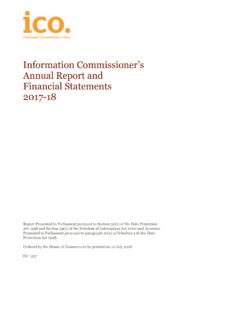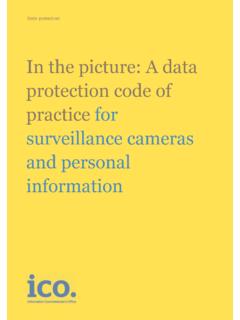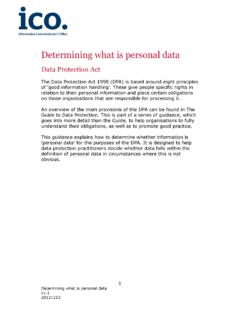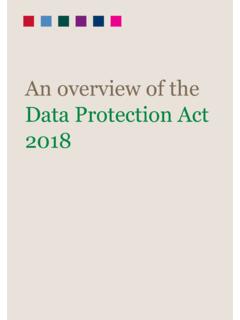Transcription of Big data, artificial intelligence, machine learning and ...
1 big data , artificial intelligence, machine learning and data protectionData protection Act and general data protection Regulation big data , artificial intelligence, machine learning and data protection 20170904 Version: Contents Information Commissioner s foreword .. 3 Chapter 1 Introduction .. 5 What do we mean by big data , AI and machine learning ? .. 6 What s different about big data analytics? .. 9 What are the benefits of big data analytics? .. 15 Chapter 2 data protection implications .. 19 Fairness .. 19 Effects of the processing .. 20 Expectations .. 22 Transparency .. 27 Conditions for processing personal data .. 29 Consent .. 29 Legitimate interests .. 32 Contracts .. 35 Public 35 Purpose limitation .. 37 data minimisation: collection and retention .. 40 Accuracy .. 43 Rights of individuals .. 46 Subject 46 Other rights.
2 47 Security .. 49 Accountability and governance .. 51 data controllers and data processors .. 56 Chapter 3 Compliance tools .. 58 Anonymisation .. 58 Privacy notices .. 62 Privacy impact assessments .. 70 Privacy by design .. 72 Privacy seals and certification .. 75 Ethical approaches .. 77 Personal data stores .. 84 Algorithmic transparency .. 86 Chapter 4 Discussion .. 90 big data , artificial intelligence, machine learning and data protection 20170904 Version: 2 Chapter 5 Conclusion .. 94 Chapter 6 Key recommendations .. 97 Annex 1 Privacy impact assessments for big data analytics .. 99 big data , artificial intelligence, machine learning and data protection 20170904 Version: 3 Information Commissioner s foreword big data is no fad. Since 2014 when my office s first paper on this subject was published, the application of big data analytics has spread throughout the public and private sectors.
3 Almost every day I read news articles about its capabilities and the effects it is having, and will have, on our lives. My home appliances are starting to talk to me, artificially intelligent computers are beating professional board-game players and machine learning algorithms are diagnosing diseases. The fuel propelling all these advances is big data vast and disparate datasets that are constantly and rapidly being added to. And what exactly makes up these datasets? Well, very often it is personal data . The online form you filled in for that car insurance quote. The statistics your fitness tracker generated from a run. The sensors you passed when walking into the local shopping centre. The social-media postings you made last week. The list goes So it s clear that the use of big data has implications for privacy, data protection and the associated rights of individuals rights that will be strengthened when the general data protection Regulation ( gdpr ) is implemented.
4 Under the gdpr , stricter rules will apply to the collection and use of personal data . In addition to being transparent, organisations will need to be more accountable for what they do with personal data . This is no different for big data , AI and machine learning . However, implications are not barriers. It is not a case of big data or data protection , or big data versus data protection . That would be the wrong conversation. Privacy is not an end in itself, it is an enabling right. Embedding privacy and data protection into big data analytics enables not only societal benefits such as dignity, personality and community, but also organisational benefits like creativity, innovation and trust. In short, it enables big data to do all the good things it can do. Yet that s not to say someone shouldn t be there to hold big data to account.
5 In this world of big data , AI and machine learning , my office is more relevant than ever. I oversee legislation that demands fair, accurate and non-discriminatory use of personal data ; legislation that also gives me the power to conduct audits, order corrective action and issue monetary penalties. Furthermore, under the gdpr my office will be working hard to improve standards in the use of personal data through the implementation of privacy seals and certification schemes. We re uniquely placed to provide the right framework for the regulation of big data , AI and machine learning , and I strongly believe that our efficient, joined-up and co-regulatory approach is exactly what is needed to pull back the curtain in this space. big data , artificial intelligence, machine learning and data protection 20170904 Version: 4 So the time is right to update our paper on big data , taking into account the advances made in the meantime and the imminent implementation of the gdpr .
6 Although this is primarily a discussion paper, I do recognise the increasing utilisation of big data analytics across all sectors and I hope that the more practical elements of the paper will be of particular use to those thinking about, or already involved in, big data . This paper gives a snapshot of the situation as we see it. However, big data , AI and machine learning is a fast-moving world and this is far from the end of our work in this space. We ll continue to learn, engage, educate and influence all the things you d expect from a relevant and effective regulator. Elizabeth Denham Information Commissioner big data , artificial intelligence, machine learning and data protection 20170904 Version: 5 Chapter 1 Introduction 1. This discussion paper looks at the implications of big data , artificial intelligence (AI) and machine learning for data protection , and explains the ICO s views on these.
7 2. We start by defining big data , AI and machine learning , and identifying the particular characteristics that differentiate them from more traditional forms of data processing. After recognising the benefits that can flow from big data analytics, we analyse the main implications for data protection . We then look at some of the tools and approaches that can help organisations ensure that their big data processing complies with data protection requirements. We also discuss the argument that data protection , as enacted in current legislation, does not work for big data analytics, and we highlight the increasing role of accountability in relation to the more traditional principle of transparency. 3. Our main conclusions are that, while data protection can be challenging in a big data context, the benefits will not be achieved at the expense of data privacy rights; and meeting data protection requirements will benefit both organisations and individuals.
8 After the conclusions we present six key recommendations for organisations using big data analytics. Finally, in the paper s annex we discuss the practicalities of conducting privacy impact assessments in a big data context. 4. The paper sets out our views on the issues, but this is intended as a contribution to discussions on big data , AI and machine learning and not as a guidance document or a code of practice. It is not a complete guide to the relevant law. We refer to the new EU general data protection Regulation ( gdpr ), which will apply from May 2018, where it is relevant to our discussion, but the paper is not a guide to the gdpr . Organisations should consult our website for our full suite of data protection guidance. 5. This is the second version of the paper, replacing what we published in 2014. We received useful feedback on the first version and, in writing this paper, we have tried to take account of it and new developments.
9 Both versions are based on extensive desk research and discussions with business, government and other stakeholders. We re grateful to all who have contributed their views. big data , artificial intelligence, machine learning and data protection 20170904 Version: 6 What do we mean by big data , AI and machine learning ? 6. The terms big data , AI and machine learning are often used interchangeably but there are subtle differences between the concepts. 7. A popular definition of big data , provided by the Gartner IT glossary, is: ..high-volume, high-velocity and high-variety information assets that demand cost-effective, innovative forms of information processing for enhanced insight and decision making. 1 big data is therefore often described in terms of the three Vs where volume relates to massive datasets, velocity relates to real-time data and variety relates to different sources of data .
10 Recently, some have suggested that the three Vs definition has become tired through overuse2 and that there are multiple forms of big data that do not all share the same traits3. While there is no unassailable single definition of big data , we think it is useful to regard it as data which, due to several varying characteristics, is difficult to analyse using traditional data analysis methods. 8. This is where AI comes in. The Government Office for Science s recently published paper on AI provides a handy introduction that defines AI as: ..the analysis of data to model some aspect of the world. Inferences from these models are then used to predict and anticipate possible future events. 4 1 Gartner IT glossary big data . Accessed 20 June 2016 2 Jackson, Sean. big data in big numbers - it's time to forget the 'three Vs' and look at real-world figures.

















